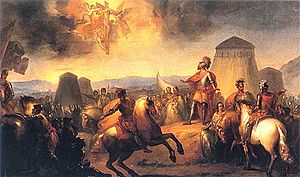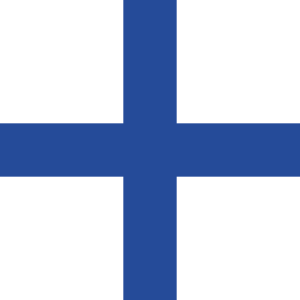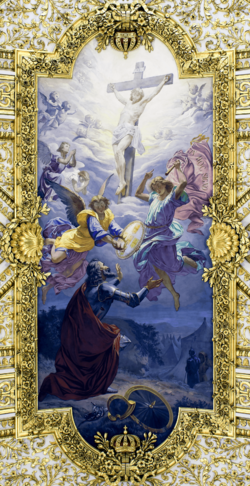Battle of Ourique facts for kids
Quick facts for kids Battle of Ourique |
|||||||
|---|---|---|---|---|---|---|---|
| Part of the Portuguese Reconquista | |||||||
 "The Miracle of Ourique" by Domingos Sequeira (1793) |
|||||||
|
|||||||
| Belligerents | |||||||
| Commanders and leaders | |||||||
| Ali ibn Yusuf Muhammad Az-Zubayr Ibn Umar |
|||||||
| Strength | |||||||
| Unknown | Unknown | ||||||
| Casualties and losses | |||||||
| Unknown | Unknown | ||||||
The Battle of Ourique was a very important fight that happened on 25 July 1139. In this battle, the forces of a Portuguese count named Afonso Henriques won a big victory. They defeated the armies led by Muhammad Az-Zubayr Ibn Umar, who was a governor from the Almoravid dynasty. Christian stories sometimes call him "King Ismar." This battle was a key moment in the history of Portugal.
Contents
Why the Battle Happened
Afonso Henriques was fighting against Alfonso VII of León in a battle called Valdevez. While he was busy there, Muslim forces attacked and destroyed two Portuguese towns, Leiria and Trancoso.
Afonso Henriques was worried about this attack on his southern border. So, he quickly made a peace deal with Alfonso VII of León. This deal was called the Treaty of Zamora. It allowed Afonso Henriques to move his troops to deal with the Muslim attack.
The Battle Itself
Historians are not completely sure where this battle took place. Back then, "Ourique" was a name for a large area south of Beja. Because writers in the 12th century didn't know the exact spot, they might have just called it "the field of Ourique."
Some historians think it would have been hard for Afonso Henriques to travel so far south. His land was mostly north of the Mondego River. They suggest the battle might have happened closer to central Portugal, perhaps near Vila Chã de Ourique, which is about 10 miles (16 km) from Santarém.
However, Christian armies sometimes did travel deep into Muslim lands. For example, Alfonso VII led expeditions that reached cities like Cordoba and Seville. It's possible Afonso Henriques led a raid into the Gharb (a Muslim region). Then, while his army was heading back, a large Almoravid force might have tried to stop them.
Before the battle, Afonso Henriques's soldiers honored him in a special way. They lifted him onto his shield and called him rex, which means king. This was a Germanic tradition.
Even though the Portuguese Christian forces were outnumbered, they won the battle. The Muslim armies had problems with their leaders, which made them weaker. After this victory, Afonso Henriques was officially declared King of the Portuguese, becoming Afonso I. Legend says he defeated and killed five Muslim kings.
Early stories about the battle don't give many details. Some say five kings led the Muslim forces, while others say it was just one king named Ismar. It's possible the "five kings" were actually leaders of different Muslim garrisons (military bases) from cities like Seville, Badajoz, Elvas, Évora, and Beja. These leaders would have been under the main command of Muhammad Az-Zubayr Ibn Umar.
What Happened After
After the battle, it was said that Afonso Henriques called for a big meeting in Lamego. This meeting was supposedly the first assembly of the estates-general (a type of parliament) of Portugal. There, he was said to have received a crown from the Archbishop of Braga. This was meant to confirm that Portugal was now independent from the Kingdom of León.
However, later historians found that the documents about this meeting were not real. They were created much later, in the 17th century, to support Portugal's independence during a time when they were fighting to restore their own rule. Even so, the idea of the Cortes of Lamego helped show that Portugal had a right to its own king and its own laws, separate from other kingdoms.
To remember the Battle of Ourique, the first Portuguese coat-of-arms was created. It included five small shields. Some people believe these shields represent the five Muslim kings who were defeated in the battle.
The Legend of Ourique
Years after the battle, a legend grew that a miracle happened during the fight. At first, some stories said Saint James helped the Portuguese. Saint James was very popular in Iberia (Spain and Portugal) and was often called the "Moor-slayer."
As Portugal became more independent, the legend changed. To make it more unique to Portugal, some stories replaced Saint James with Saint George, and later, with Jesus Christ.
In the most famous version of the legend, an old man visited Afonso Henriques before the battle. The old man said he had a dream that God would help Afonso win. He told Afonso to leave his camp alone when he heard a chapel bell. When Afonso did this, a bright light appeared. In the light, he saw the sign of the cross and Jesus Christ on a crucifix. Afonso knelt down and heard Christ's voice, who told him he would defeat the Almoravids. The legend says Afonso won the next day because of his courage and faith.
This legend of the miracle at Ourique became a powerful story. It helped people believe that Portugal's independence was God's will. The story first appeared in a book called Crónica de Portugal de 1419. It was believed for a long time until a historian named Alexandre Herculano studied it in the 19th century and said it was a "pious fraud" (a well-meaning lie).
See also
 In Spanish: Batalla de Ourique para niños
In Spanish: Batalla de Ourique para niños
- Siege of Lisbon
- Timeline of Portuguese history
Images for kids






